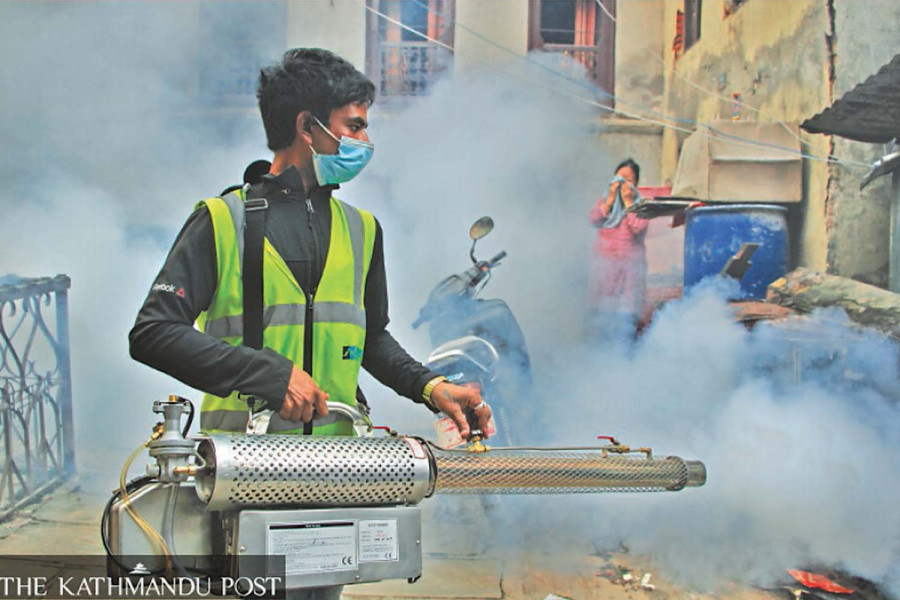Health
Over 800 dengue cases reported from 57 districts since January
All three districts of the Kathmandu Valley—Kathmandu, Lalitpur, and Bhaktapur—report dengue infections. Dengue-transmitting mosquitoes breed in clean water.
Post Report
Over 800 people from 57 districts, including Kathmandu, Bhaktapur, and Lalitpur have tested positive for the dengue virus since January this year.
As dengue became endemic in Nepal years ago, meaning people get infected throughout the year, health officials no longer consider the virus an outbreak of a deadly infection.
“We don’t call it an outbreak because the virus has already become endemic in our country,” said Dr Gokarna Dahal, chief of the Vector Control Section at the Epidemiology and Disease Control Division. “But we have alerted all agencies concerned about the rising risks.”
Dengue is a mosquito-borne disease transmitted by the female Aedes aegypti and Aedes albopictus mosquitoes. The same vector also transmits chikungunya, yellow fever, and Zika, according to the World Health Organisation.
At least 15 died, and 41,865 others were infected by the deadly virus in 2024 as the virus spread in 76 districts. Experts say reported cases may only represent a small fraction of the true scale of the dengue outbreak, as around 90 percent of the infected people show no symptoms and health authorities often underreport deaths and infections.
Many people infected with dengue show mild symptoms, which do not need any treatment or can be managed with paracetamol at home.
As there is no specific treatment for dengue, health workers provide symptomatic care, including platelet-rich plasma transfusion.
Previously it was thought that dengue-spreading mosquitoes do not get active when the temperature declines below 15 degrees Celsius. However, the continuous spread of the virus during colder months raises questions about this assumption.
Data from the Division show that at least 1,323 people were infected with the virus in the month of Paush (December 16 to January 13) and 853 in Magh (January 14 to February 12). Of the total cases, 151 needed hospitalisation and six had severe infections.
Health officials said that they have alerted relevant agencies in the disease-hit districts about the growing risks, as rising temperatures, coupled with pre-monsoon rainfall create the perfect environment for dengue-spreading vectors to breed.
“We have been coordinating with local units, from which dengue cases have been reported,” said Dahal. “We have already held a meeting with representatives of several health offices, including the health offices of Kathmandu Valley, and have requested them to carry out a search and destroy drive to lessen the risk of massive spread of the virus.”
The division stated that it has requested local governments to utilise the budget allocated for preventive measures against the dengue virus in the current fiscal year.
Experts say that unless the general public is made aware of the problem and takes it seriously, the spread of the dengue virus will not lessen. They asked the authorities concerned to learn from past experiences while taking preventive measures.
“We do have our own experiences of success and failures while dealing with the dengue virus,” said Dr Sher Bahadur Pun, chief of the Clinical Research Unit at Sukraraj Tropical and Infectious Hospital. “We should learn from the experiences we gained and take measures accordingly to suppress the massive spread of the virus.”
Along with launching a search-and-destroy drive on a regular basis, authorities should also focus on strengthening the capacity of health facilities to prevent them from being overwhelmed in the event of a possible massive outbreak, experts say.
Dengue-transmitting mosquitoes breed in clean water and bite people in daylight. Uncovered water tanks and discarded objects such as plastic cups and bottles could be breeding grounds for dengue-carrying mosquitoes.
According to doctors, mild to high fever, severe muscle pain, rashes, severe headache and pain in the eyes are some symptoms of dengue. Doctors advise those with these symptoms to seek immediate treatment. While there is no specific cure for the disease, early detection and access to proper medical care can lower fatalities.
Nepal reported its first dengue case in a foreigner in 2004 in Chitwan district. Since then, an increasing number of dengue infections, including major outbreaks, have been reported from many districts.
The World Health Organisation says there is no specific cure for severe dengue, but early detection and access to proper medical care can save lives.




 20.97°C Kathmandu
20.97°C Kathmandu












.jpg&w=300&height=200)

